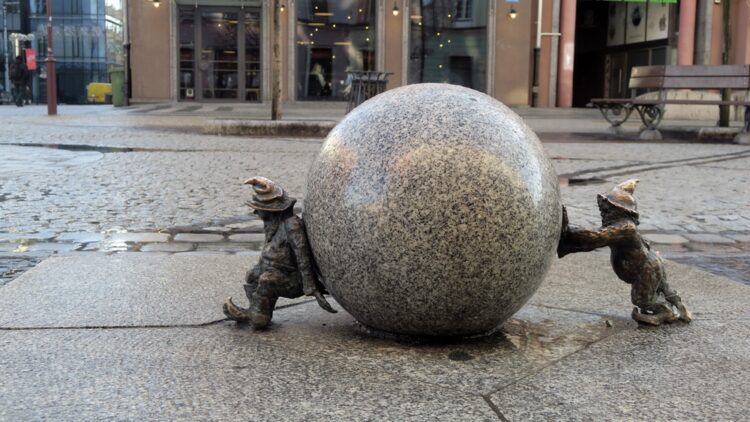I don’t think I’ve ever visited a more whimsical destination than the enchanting Polish city of Wroclaw. From the colorful houses that are straight out of a Grimm’s fairy story to the hundreds of scattered gnomes that can be spotted throughout the downtown area, this is a city like no other. The third largest urban area in Poland, it’s often overlooked by visitors who head straight to Krakow and Warsaw. Big mistake.
I visited Wroclaw (pronounced vrots-waff) during the winter, and it was made even more magical by the light covering of snow and Christmas lights. Festive decorations and Christmas trees remain up until February in Poland, brightening up the darkest months of the year. The most popular time to visit is in December, when the oldest and largest Christmas market in Poland takes place. However, Wroclaw is special at any time of the year and during the summer months visitors can enjoy the many parks, beer gardens and outdoor cafes.
One of the most fun activities in Wroclaw is to set out on a gnome hunt. Bronze sculptures of gnomes no larger than a foot tall, can be found all over the city, engaged in a variety of activities from watching TV to riding a motorbike. Many are placed in front of businesses. A gnome proffering a ring can be seen standing in front of the jewelers in the main square. Outside a pub, a jovial gnome toasts a bulldog with a pint of beer. A gnome holding a pretzel is positioned in front of a bakery.
Back in the 1980’s an anti-communist movement known as the Orange Alternative established itself in Wroclaw. The movement used humorous concepts and peaceful protest to challenge communist ideologies and encourage free-thinking. The gnomes became their symbol along with a catchphrase – There is no freedom without dwarves! Although the movement only continued for a few years, the gnome phenomenon continued and there are now in the region of eight hundred gnomes dispersed throughout the city. The larger Papa Dwarf, located on Swidnicka Street, is a statue dedicated to the founder of the movement, Waldemar Fydrych.
When you’re gnomed-out, make tracks to The Passage, a haunting sculpture located a ten-minute walk from the main square. Created by Polish artist, Jerzy Kalina, it portrays a group of people sinking into the sidewalk on one side of Swidnicka Street and re-emerging on the other. Representing those who disappeared under martial law during the communist era, it’s a emotive piece of art which is well worth seeking out.
The medieval market square is situated in the heart of the city. Surrounded by pastel colored renaissance and gothic style houses, walking into the square is akin to stepping into a fairytale. The town hall resembles a gingerbread house, and of course, there are an abundance of gnomes. The double towers of Mary Magdelene’s Church are connected by Witches Bridge. Steeped in legend, it’s said that women accused of witchcraft were made to walk across the bridge in ancient times. Many fell to their deaths and were exonerated. Those who made it across were believed to be aided by the devil and were consequently burnt at the stake. The bridge is a challenging 200 steps, but anyone making the ascent is rewarded with stunning views of the city and a chance to see the ‘witchy gnome’ statue on the bridge.
Wroclaw is a compact city, and all the major sights are walkable. Known as the Venice of the North, the city is home to twelve islands and a hundred bridges which cross numerous rivers and canals. The main waterway, which runs through the city, is the River Oder. Cathedral Island (Ostro Tumski) is one of the oldest neighborhoods and can be reached by crossing two of the city’s bridges. Grand religious buildings line the cobbled streets, and the magnificent Cathedral of John the Baptist is situated at its center. At dusk a lamplighter attired in a black cloak and top hat walks through the streets and ignites 103 gas lamps. It’s a tradition from centuries ago, which rather charmingly, still exists to this day.
In contrast to Wroclaw’s old-world charm, the Neon Side Gallery, tucked away in a courtyard at Ruska 46, is an impressive enclave of soviet-era neon signs and street art. The thirty signs which have been salvaged from bars, cinemas and stores from all over Poland are best viewed at night when they are illuminated. There’s a lively bar scene in the vicinity too, so swing by for a shot of vodka or bottle of Polish beer after viewing the neon. Craft beer has become popular in Wroclaw in recent years and there are several specialist bars in the city.
Whether in the mood for traditional Polish fare or international cuisine, Wroclaw has some excellent restaurants to try. The street food is pretty good too. My favorite two discoveries were donuts and dumplings, both of which proved too tempting to resist. Packzi are donuts filled with a variety of flavors from apple and cinnamon to salted caramel. For those who prefer their snacks savory, Pierogi are delicious – boiled dumplings stuffed with a choice of meat, vegetables or cheese.
I have to be honest, I’d never even heard of Wroclaw before I read about its extraordinary assortment of gnomes in a travel book. I knew then that I would have pay a visit to this unique city. I’m so glad that I did. Although many cities have beautiful architecture, cute coffee shops and culture aplenty, Wroclaw has a sprinkling of magic rarely found elsewhere. If you are heading to Poland, do yourself a favor and make sure this delightful city is on your itinerary.

